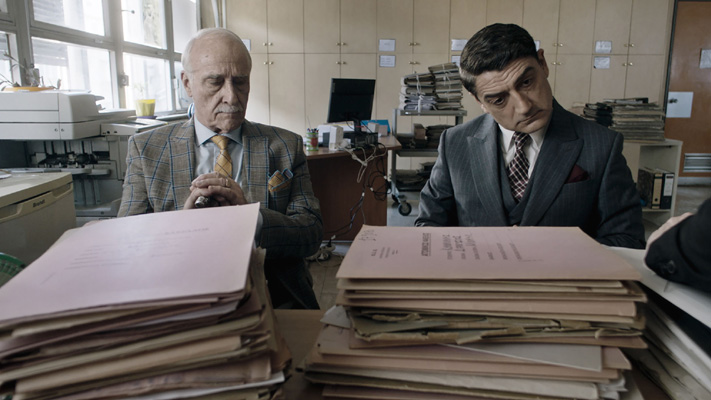Lisa van der Waal looks at an entertaining and thoughtful ode to the art of designing tailor-made clothes in a film that is full of nostalgia, humor, generational conflicts and secret love that won the critics’ prize in the Greek Film Festival Competition.
The tapping sound of a foot pedal of an old sewing machine, the noise of the machine’s fast rolling wheel, the ticking of the needle, and a flute starts to play a happy tune. Right from its musical beginning, Sonia Liza Kenterman’s debut film Tailor (2020) grabs your attention and lets you smile. Presented as a coming-of-old-age film, Tailor is above all an ode to the art of making clothes, full of nostalgia, humor, generational conflicts and secret love. Tailor won the FIPRESCI Prize at the 61st edition of the Thessaloniki International Film Festival.
Tailor Nikos (Dimitris Imellos) is a peculiar man who lives in the attic of his father’s tailor shop, specialising in tailor-made costumes. When the bank threatens to repossess the shop and his father falls ill, Nikos thinks up a plan. He goes to a local market with a tiny tailor shop on wheels in order to attract new customers and pay his father’s debts. Everyone thinks Nikos is going crazy. Meanwhile, the tailor does effectively attract new customers, the type of creatures he is not familiar with, neither in his professional nor in his personal life…women.
Full of self-confidence about his skills and full of awkwardness in his handling of female customers’, Nikos makes one (wedding) dress after the other. He gets a little help from his neighbour Olga (Tamilla Koulieva), on whom Nikos also has an eye on. The tension between the two is represented in a very subtle, childishly cute and therefore classy way. Olga is married and has a daughter, after all. If Nikos’ life-changing experiences are not exciting enough already, his father tells him that he feels embarrassed and rejects his son’s actions: “Wedding dresses are for seamstresses. We are tailors.” Nikos does not see the problem. Sewing is sewing.
The sepia colours that dominate in Tailor emphasise the nostalgic look and feel of the film that actually represents the time Nikos’ mind is still living in. Nikos is a well-mannered man, always dressed-up, whether he is a guest at a wedding or working in his atelier. Moreover, he is used to the idea that tailor-made clothes are the standard in Greek society and that his customers have to pay quite an amount for a tailor-made piece of cloth. His first customers are in shock when he mentions the price he asks for his designs. Meanwhile, the Greek women teach him how a contemporary woman wants to be treated and seen, especially at a wedding.
Via close-ups of the details that the craftsmanship of a tailor contains, such as sizing the measures of one’s body, drawing a pattern on a piece of fabric, sewing (both with a machine and by hand), Kenterman emphasises the extraordinary craft of making clothes. The director also shows how focused a tailor can be on mistakes in clothes. From time to time, Nikos picks a loose thread of a dress or a suit. Based on this, one of the most humorous scenes of the film was made. When Nikos and his father visit a banker, Nikos has the urgent tendency to tear a loose thread of the banker’s suit. His father warns his son. When the banker stands up, Nikos takes the opportunity and grabs the thread, which becomes longer and longer. This action is magnificently accompanied by the sound of a violin.
Kenterman has delivered not just a feel good debut film that leaves you with a good feeling. Yes, Tailor is very accessible, but it is also a thoughtfully constructed film that portrays both an older and contemporary Greek society via a man’s personal struggles with money, love, dreams and adapting to modern times, while maintaining the standards and values you have learned decades ago. Did everything used to be better in the past? That’s not necessarily what Kenterman wants to preach. It is rather that the contemporary generation can learn or cherish from the older ones – and definitely the other way around as well.
Lisa van der Waal
© FIPRESCI 2020
Edited by Steven Yates

